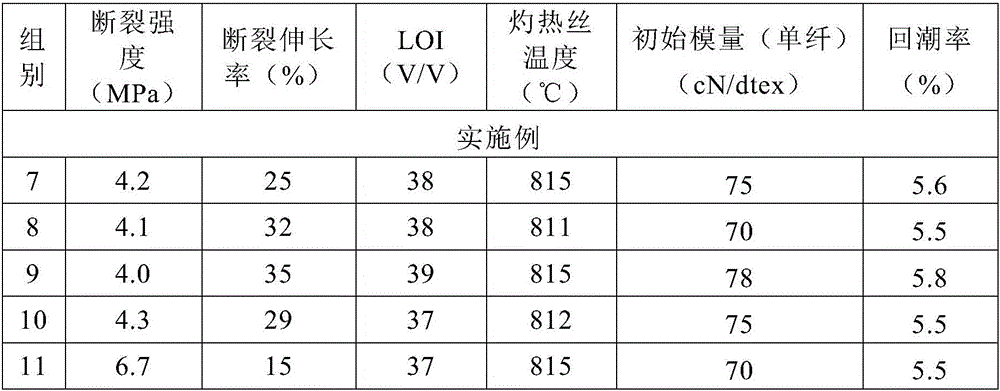Polyamide 56 material prepared from bio-based 1,5-pentamethylene diamine
A technology of polyamide and pentamethylene diamine, which is applied in the field of polyamide materials, can solve the problems affecting the application of flame-retardant polyamide materials, the high cost of flame-retardant materials, and the increase of potential safety hazards, and achieves wide industrial application prospects and excellent resistance. Burning effect, high safety effect
- Summary
- Abstract
- Description
- Claims
- Application Information
AI Technical Summary
Problems solved by technology
Method used
Image
Examples
Embodiment 1
[0086] The preparation of embodiment 1 polyamide 56 flame retardant material
[0087] (1) Mix adipic acid, 1,5-pentanediamine, melamine cyanurate (MCA) and water in the reactor evenly, wherein the weight sum of dibasic acid and diamine accounts for 50% of the total weight of the solution %, take a small amount of salt solution and dilute to 10% and detect that the pH value is 8.22 at 25°C to make a polyamide 56 salt solution with a mass percent concentration of 50%; wherein, the addition of MCA is 3% (percentage is 3% of polyamide 56% by mass of flame retardant material);
[0088] (2) The polyamide 56 salt solution is concentrated to a polymer concentration of 80% under the conditions of a pressure of 0.3 MPa and a temperature of 120°C;
[0089] (3) Heating the system, gradually increasing the pressure to 1.8MPa, and maintaining the pressure for prepolymerization until the system temperature reaches 245°C;
[0090] (4) Gradually reduce the pressure until the vacuum degree re...
Embodiment 2
[0094] Preparation of embodiment 2 polyamide 56 flame retardant material
[0095] (1) Mix adipic acid, 1,5-pentanediamine, melamine phosphate and water in the reactor, wherein the sum of dibasic acid and diamine accounts for 60% of the total weight of the solution, and both The molar ratio is 1:1.1, and the addition amount of melamine phosphate is 5% (the percentage is the mass percentage accounting for the polyamide 56 flame retardant material);
[0096] (2) The polyamide 56 salt solution is concentrated to a polymer concentration of 70% under the conditions of a pressure of 0.15 MPa and a temperature of 150°C;
[0097] (3) Heating the system, gradually increasing the pressure to 1.5MPa, and maintaining the pressure for prepolymerization until the system temperature reaches 255°C;
[0098] (4) Gradually reduce the pressure until the vacuum degree reaches -0.1MPa (gauge pressure), and the system temperature reaches 275°C;
[0099] (5) The system is maintained at -0.1MPa, and...
Embodiment 3
[0102] Preparation of embodiment 3 polyamide 56 flame retardant material
[0103] (1) Adipic acid, 1,5-pentanediamine, melamine polyphosphate and water are mixed uniformly in a reactor, wherein the weight sum of dibasic acid and diamine accounts for 60% of the total weight of the solution, and two The molar ratio is 1:1.1, and the addition of melamine polyphosphate is 5% (percentage is the mass percentage accounting for polyamide 56 flame retardant material);
[0104] (2) The polyamide 56 salt solution is concentrated to a polymer concentration of 80% under the conditions of a pressure of 0.1 MPa and a temperature of 120°C;
[0105] (3) Heating the system, gradually increasing the pressure to 1.6MPa, and maintaining the pressure for prepolymerization until the system temperature reaches 250°C;
[0106] (4) Gradually reduce the pressure until the degree of vacuum reaches -0.09MPa (gauge pressure), and the system temperature reaches 240°C;
[0107] (5) The system is maintained...
PUM
 Login to View More
Login to View More Abstract
Description
Claims
Application Information
 Login to View More
Login to View More - R&D
- Intellectual Property
- Life Sciences
- Materials
- Tech Scout
- Unparalleled Data Quality
- Higher Quality Content
- 60% Fewer Hallucinations
Browse by: Latest US Patents, China's latest patents, Technical Efficacy Thesaurus, Application Domain, Technology Topic, Popular Technical Reports.
© 2025 PatSnap. All rights reserved.Legal|Privacy policy|Modern Slavery Act Transparency Statement|Sitemap|About US| Contact US: help@patsnap.com



